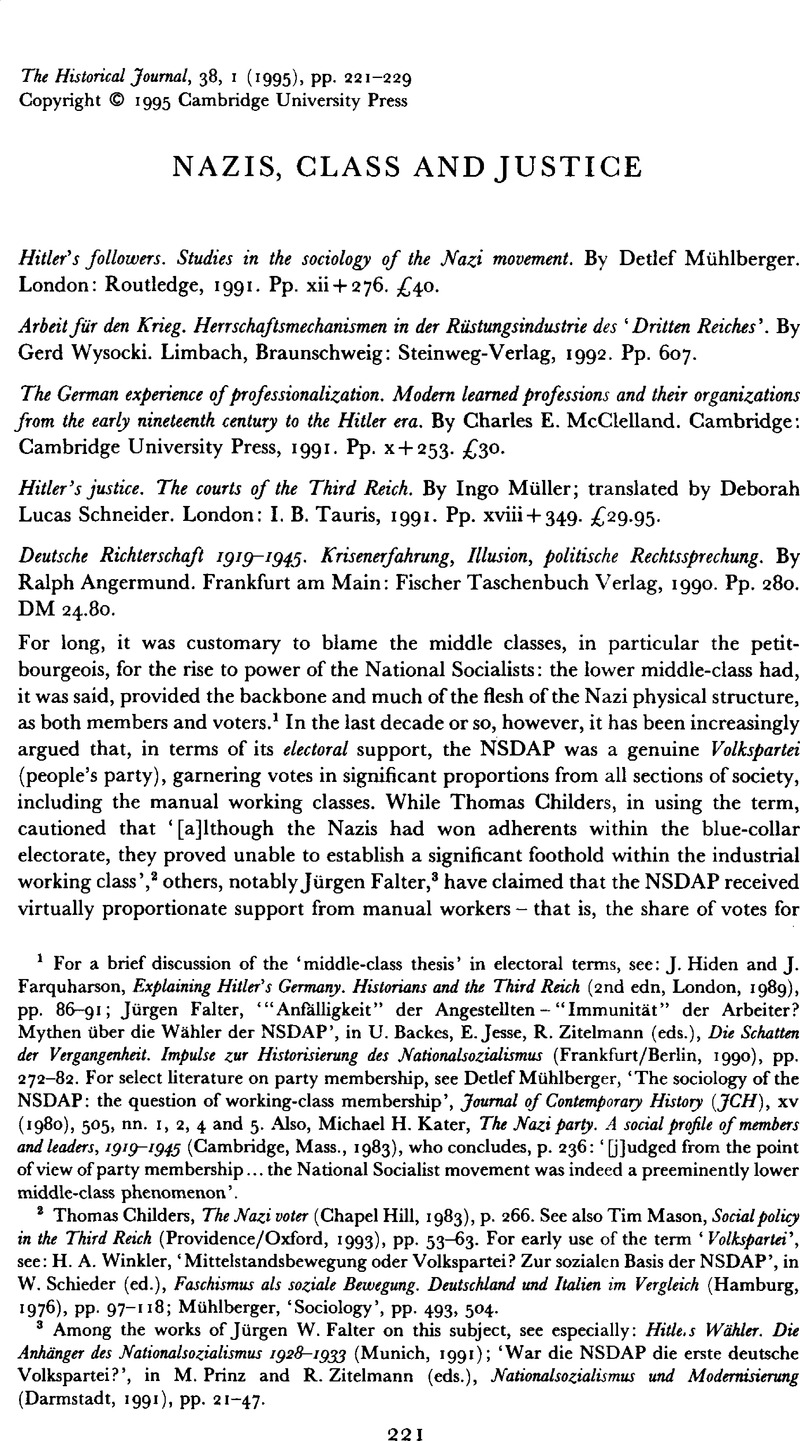No CrossRef data available.
Article contents
Nazis, class and justice
Published online by Cambridge University Press: 11 February 2009
Abstract

- Type
- Review Articles
- Information
- Copyright
- Copyright © Cambridge University Press 1995
References
1 For a brief discussion of the ‘middle-class thesis’ in electoral terms, see: Hiden, J. and Farquharson, J., Explaining Hitler's Germany. Historians and the Third Reich (2nd edn, London, 1989), pp. 86–91Google Scholar; Jurgen, Falter, ‘“Anfälligkeit” der Angestellten – “Immunität” der Arbeiter? Mythen über die Wähler der NSDAP’, in Backes, U., Jesse, E., Zitelmann, R. (eds.), Die Schatten der Vergangenheit. Impulse zur Historisierung des Nationalsozialismus (Frankfurt/Berlin, 1990), pp. 272–82Google Scholar. For select literature on party membership, see Detlef, Mühlberger, ‘The sociology of the NSDAP: the question of working-class membership’, Journal of Contemporary History (JCH), XV (1980), 505Google Scholar, nn. 1, 2, 4 and 5. Also, Kater, Michael H., The Nazi party. A social profile of members and leaders, 1919–1945 (Cambridge, Mass., 1983)Google Scholar, who concludes, p. 236: ‘ [j]udged from the point of view of party membership… the National Socialist movement was indeed a preeminently lower middle-class phenomenon’.
2 Thomas, Childers, The Nazi voter (Chapel Hill, 1983), p. 266Google Scholar. See also Tim, Mason, Social policy in the Third Reich (Providence/Oxford, 1993), pp. 53–63Google Scholar. For early use of the term ‘Volkspartei’, see: Winkler, H. A., ‘Mittelstandsbewegung oder Volkspartei? Zur sozialen Basis der NSDAP’, in Schieder, W. (ed.), Faschismus als soziale Bewegung. Deutschland und Italien im Vergleich (Hamburg, 1976), pp. 97–118Google Scholar; Mühlberger, , ‘Sociology’, pp. 493, 504.Google Scholar
3 Among the works of Falter, Jürgen W. on this subject, see especially: Hitle.s Wähler. Die Anhänger des Nationalsozialismus 1928–1933 (Munich, 1991)Google Scholar; ‘War die NSDAP die erste deutsche Volkspartei?’, in Prinz, M. and Zitelmann, R. (eds.), Nationalsozialismus und Modemisierung (Darmstadt, 1991), pp. 21–47.Google Scholar
4 Thomas, Childers, Jane, Caplan, ‘Introduction’, in Childers, T. and Caplan, J. (eds.), Reevaluating the Third Reich (New York, 1993), p. 14, n. 6.Google Scholar
5 Detlef, Mühlberger, Hitler's followers (London, 1991), p. 82.Google Scholar
6 Ibid. p. 202.
7 Ibid. pp. 31, 46–9. Wilfried, Böhnke, Die NSDAP im Ruhrgebiet 1920–1933 (Bonn/Bad Godesberg, 1974).Google Scholar
8 Mühlberger, , Hitler's followers, p. 116.Google Scholar
9 McClelland, Charles E., The German experience of professionalizatim (Cambridge, 1991), pp. 177, 218CrossRefGoogle Scholar; Ralph, Angermund, Deutsche Richterschaft 1919–1945 (Frankfurt a.M., 1990), pp. 31–4, 38–41, 44Google Scholar; Jarausch, Konrad H., ‘The crisis of the German professions 1918–1933’, Journal of Contemporary History, XX (1985), especially pp. 386–94Google Scholar; Kater, Michael H., ‘Professionalization and socialization of physicians in Wilhelmine and Weimar Germany’, JCH, XX (1985), pp. 689–93.Google Scholar
10 McClelland, , German experience, pp. 194, 214Google Scholar; Angermund, , Richterschaft, pp. 21–2, 30.Google Scholar
11 Mühlberger, , Hitler's followers, pp. 17, 78, 206.Google Scholar
12 Ibid. pp. 17, 78, 205–6.
13 Ibid. p. 209.
14 Mason, Social policy, especially chapters 5 and 6.
15 For example: Klaus-Jörg, Siegfried: Rüstungsproduktion und Zwangsarbeit im Volkswagenwerk 1939–1945 (Frankfurt a.M., 1986)Google Scholar; Das Leben der Zwangsarbeiter im Volkswagenwerk 1939–1945 (Frankfurt a.M., 1988)Google Scholar; Kaspar, B., Schuster, L., Watkinson, C., Arbeiten für den Krieg. Deutsche und Ausländer in der Rüstungsproduktion bei Rheinmetall-Borsig 1943–1945 (Hamburg, 1987).Google Scholar
16 For example: Ulrich, Herbert: Fremdarbeiter. Politik und Praxis des ‘Ausländer-Einsatzes’ in der Kriegswirtschaft des Dritten Reiches (Berlin/Bonn, 1985)Google Scholar; Europa und der ‘Reichseinsatz’ Ausländische Zivilarbeiter, Kriegsgefangene und KZ-Häftlinge in Deutschland 1939–1945 (Essen, 1991)Google Scholar; Christoph, Schminck-Gustavus (ed.), Hungem für Hitler. Erinnerungen polnischer Zwangsarbeiter im Deutschen Reich 1940–1945 (Reinbek, 1984).Google Scholar
17 Gerd, Wysocki, Arbeit für den Krieg (Limbach, 1992), pp. 456–7.Google Scholar
18 Ibid. p. 196.
19 Ibid. pp. 393–9, 417–32, 440–55.
20 Konrad, Jarausch, The unfree professions, 1900–1950 (New York, 1990)Google Scholar; Kater, Michael H., Doctors under Hitler (Chapel Hill, 1989)Google Scholar. Both authors have also written numerous essays and articles on their subject. See also Lifton, R. J., The Nazi doctors (New York, 1986)Google Scholar; Paul, Weindling, Health, race and German politics between national unification and Nazism, 1870–1945 (Cambridge, 1989)Google Scholar; Michael, Burleigh and Wolfgang, Wippermann, The racial state. Germany 1933–1945 (Cambridge, 1991)Google Scholar, especially chapters 3, 5 and 6.
21 Ibid, especially pp. 94–8. Also: Hans, Robinsohn, Justiz als politische Verfolgung (Stuttgart, 1977)Google Scholar; Ingo, Müller, Hitler's justice (London, 1991)Google Scholar; Angermund, Richterschaft.
22 E.g. McClelland, Charles E.: ‘Professionalization and higher education in Germany’, in Jarausch, K. H. (ed.), The transformation of higher learning, 1860–1930 (Stuttgart, 1982)Google Scholar; ‘Die deutschen Hochschullehrer als Elite, 1815–1850’, in Schwabe, K. (ed.), Deutsche Hochschullehrer als Elite, 1815–1945 (Boppard, 1988).Google Scholar
23 McClelland, , German experience, p. 243.Google Scholar
24 Ibid. p. 235.
25 Ibid. p. 51.
26 Ibid. p. 7.
27 Ibid. p. 218.
28 Müller, , Hitler's justice, p. 76.Google Scholar
29 Ibid. p. 118.
30 Angermund, , Richterschaft, p. 75.Google Scholar
31 Hubert, Schorn, Der Richter im Dritten Reich (Frankfurt, 1959)Google Scholar is the most flagrant example of post-war apologetics.
32 Müller, , Hitler's justice, p. 215.Google Scholar
33 Angermund, , Richterschaft, p. 10.Google Scholar
34 Müller, , Hitler's justice, p. 284.Google Scholar
35 Peukert, Detlev J. K., Inside Nazi Germany. Conformity, opposition and racism in everyday life (London, 1987), p. 96.Google Scholar
36 McClelland, , German experience, p. 177.Google Scholar
37 Norbert, Frei, National Socialist rule in Germany. The Führer state 1933–1945 (Oxford, 1993), p. 124.Google Scholar
38 McClelland, , German experience, p. 228.Google Scholar


